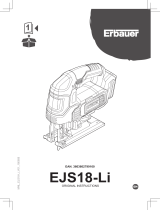
ENGLISH en
9
Original instructions
We declare under our sole responsibility: These
cordless sabre saws, identified by type and serial
number *1), comply with all relevant requirements of
the directives *2) and standards *3). Technical file
at *4) - see page 3.
For UK only:
We as manufacturer and authorized person to
compile the technical file, see *4) on page 3,
hereby declare under sole responsibility that these
cordless sabre saws, identified by type and serial
number *1) on page 3, fulfill all relevant provisions of
following UK Regulations *2) S.I. 2016/1091, S.I.
2008/1597, S.I. 2012/3032 and Designated
Standards EN 62841-1:2015, EN 62841-2-
11:2016, EN IEC 63000:2018.
The tool is suitable for sawing wood, metals,
plastics or similar materials such as hard rubber,
fibre glass, etc.
Warranty claims apply only to a limited extent for
applications with excessive wear (e.g. pallet
construction/repair).
The user bears sole responsibility for any damage
caused by unspecified use.
Generally accepted accident prevention
regulations and the enclosed safety information
must be observed.
For your own protection and for the
protection of your electrical tool, pay
attention to all parts of the text that are
marked with this symbol!
WARNING – Reading the operating instruc-
tions will reduce the risk of injury.
WARNING – Read all safety warnings,
instructions, illustrations and
specifications provided with this power tool.
Failure to follow all instructions listed below may
result in electric shock, fire and/or serious injury.
Save all warnings and instructions for future
reference. Pass on your electrical tool only
together with these documents.
Hold the power tool by insulated gripping
surfaces, when performing an operation where
the cutting accessory may contact hidden
wiring. Cutting accessory contacting a "live" wire
may make exposed metal parts of the power tool
"live" and could give the operator an electric shock.
Use clamps or another practical way to secure
and support the workpiece to a stable platform.
Holding the work by your hand or against the body
leaves it unstable and may lead to loss of control.
Remove the battery pack from the machine before
any adjustment or maintenance is carried out.
Before fitting the battery pack, make sure that the
machine is switched off.
CAUTION Do not stare at operating lamp.
Protect battery packs from water and
moisture!
Do not expose battery packs to naked flame!
Do not use faulty or deformed battery packs!
Do not open battery packs!
Do not touch or short-circuit battery packs!
Slightly acidic, flammable fluid may leak from
defective Li-ion battery packs!
If battery fluid leaks out and comes into contact
with your skin, rinse immediately with plenty of
water. If battery fluid leaks out and comes into
contact with your eyes, wash them with clean water and
seek medical treatment immediately.
If the machine is defective, remove the battery pack
from the machine.
Always wear protective goggles, gloves, and sturdy
shoes when working with this tool.
Ensure that the spot where you wish to work is
free of power cables, gas lines or water pipes
(e.g. using a metal detector).
When sawing water pipes, ensure that they do not
contain any water.
Wear ear protectors when working for long
periods of time. High noise levels over a
prolonged period of time may affect your hearing.
Materials that generate dusts or vapours that may
be harmful to health (e.g. asbestos) must not be
processed.
Do not reach under the workpiece while the
machine is in operation.
Do not try to saw extremely small workpieces.
Clamp the workpiece firmly. Under no
circumstances should you hold the workpiece with
your hand or foot.
Only use sharp, undamaged saw blades. Do not
use saw blades that are cracked or that have
changed their shape.
For sawing, the guide must make secure contact
with the workpiece.
Always hold the machine with both hands at the
intended handles, take a secure stance and
concentrate on the work.
Danger of injury due to the sharp saw blade.
1. Conformity Declaration
2. Specified Use
3. General Safety Instructions
4. Special Safety Instructions












